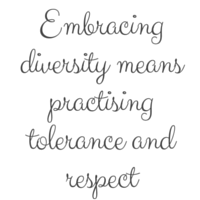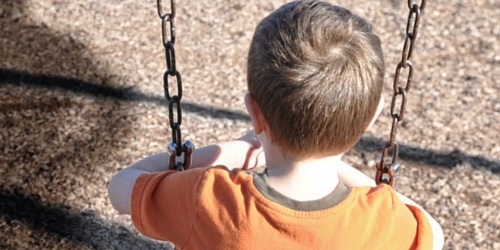- Welcome
- Diversity
Embracing Diversity
Embracing diversity means practising tolerance and accepting differences in others. Teaching children to be tolerant and accepting difference starts at home. But can we help our kids to become responsible, caring and tolerant?
We all want to raise broad-minded children, who are open to new experiences, who do not prejudge, discriminate or impose their opinions on others, who listen, help and care. We want them to develop into responsible adults, to be caring and tolerant. To enable them to become role models themselves later on, kids need to be shown in a loving way how they do things correctly, how to deal with failure and how to interact with others. And here is where parents and teachers come in. We are the ultimate role model for our children. We need to lead the way.
Embracing Diversity:
Developing young minds
As our children have been exposed to various cultures from an early age, we know from experience that children react to differences early on. Children realise that there are different ways how people look, how they act or how they communicate with each other. Social interaction has an tremendous influence on young minds, as kids learn by imitating actions and behaviour. If children get exposed to various cultures and languages early on, they develop a wider set of cultural insights and cultural cues as well.
 Embracing Diversity
Embracing DiversityTeaching your Kids about Diversity
We all know that family
traditions, cultural and religious rituals influence the young minds. Children need to learn from an early age to not prejudge others, to tolerate difference and show respect for others and for themselves. Similarities with others have to be recognized and differences in appearance or behaviour, beliefs and social backgrounds have to be openly discussed with your child from an early age.

Tolerance and acceptance of diversity have to be lived daily at home to become a normal routine for children. Exposure to diverse situations, people and surroundings offer valuable input. Different intellectual and physical abilities, different racial, religious and sexual orientation needs to be noticed or encountered and discussed, so stigma and stereotypes do not play a role in forming your child's viewpoints.
As young children are influenced mainly by their parents and guardians, these and other influencers such as TV shows or computer games, play a vital role as they shape the children’s world view. At school-going age, children usually become more aware of economic differences and realise that the status and attitude of another person is often displayed also in clothing, available toys and possessions or in a different lifestyle. Then children start to question many of the family's routines and will be also influenced by others, who might have other social backgrounds, faiths and beliefs.
Make sure to embrace difference by teaching or learning with your children about the various cultural and religious traditions and explore and discuss preferences. Be open to new experiences, so your child will become more accepting and tolerant as well.
10 Tips for Parents and Teachers:
Embracing Diversity
- Explore and discuss culture and traditions of foreign countries. See our 'Helpful Resources' in the box below.
- Read up and discuss different religions and their various rituals and traditions. See 'Helpful Resources' in box below.
- Try new or foreign food, prepare ethnic food or have a meal at an ethnic restaurant and explore different spices, dishes and tastes.
- Set up play-dates or meetings with new friends or reconnect with friends and family members which you have not seen for a long time and which might come from different backgrounds.
- Visit a home for the elderly or disabled persons, a children's home for orphans or a shelter for the homeless or refugees to learn about other people’s struggles and challenges in life
- Focus on the positive. Try to say only good things for the whole day. Challenge negative attitudes and look out for positive qualities. Create together a positive quote of the week.
- Join fund-raising events and support good causes. Visit schools for special needs children or a children’s home with your child. They will appreciate your time, effort and support.
- Together with your child, practise friendly small talk with a stranger in a safe environment. Remember to always be present and teach the child not to give away personal information but simply learn to be open to new situations and lead some friendly small talk.
- Make children aware of differences and uniqueness. Appreciate differences and acknowledge uniqueness. Praise good deeds and develop strong self-esteem and counteract insecurities.
- Travel as much as you can. If money is tight, you can also explore places near your home, join new community activities, and thus meet new people and embrace diversity!
Embracing Diversity
Useful Resources for Further Reading
Recommended Reading on 'Embracing Diversity'
Useful Websites to explore
- Explore the food of the world: BBC Cuisines of the World
- National Geography for Kids: Weekly news page for kids
- Kids-World-Travel-Guide: Country Facts. See the world through children's eyes.
- Information about various religions (comprehensive infosite that includes references for further reading)
- World Religions Homework Help by Woodlands Primary School
About
Regina Gräff is the founder and editor of ExpatCapeTown.com and Kids-World-Travel-Guide.com and co-author of the 'Living in South Africa' handbook. Born and raised in Germany, she has a degree (MA phil) in languages and intercultural communication. Regina is a serial expat and has worked as a teacher and educational consultant in various countries including the USA, Australia, Singapore and the UK. Since 2005, she lives with her family in Cape Town/South Africa.
Follow me on twitter, join our discussion, subscribe to our newsletter... Looking forward to hearing from you.
Related Posts
10 Activities for Teaching Diversity in the Classroom |
How to recognise if your child is being bullied? |
Image Credit on page about Embracing Diversity: Shutterstock.com

